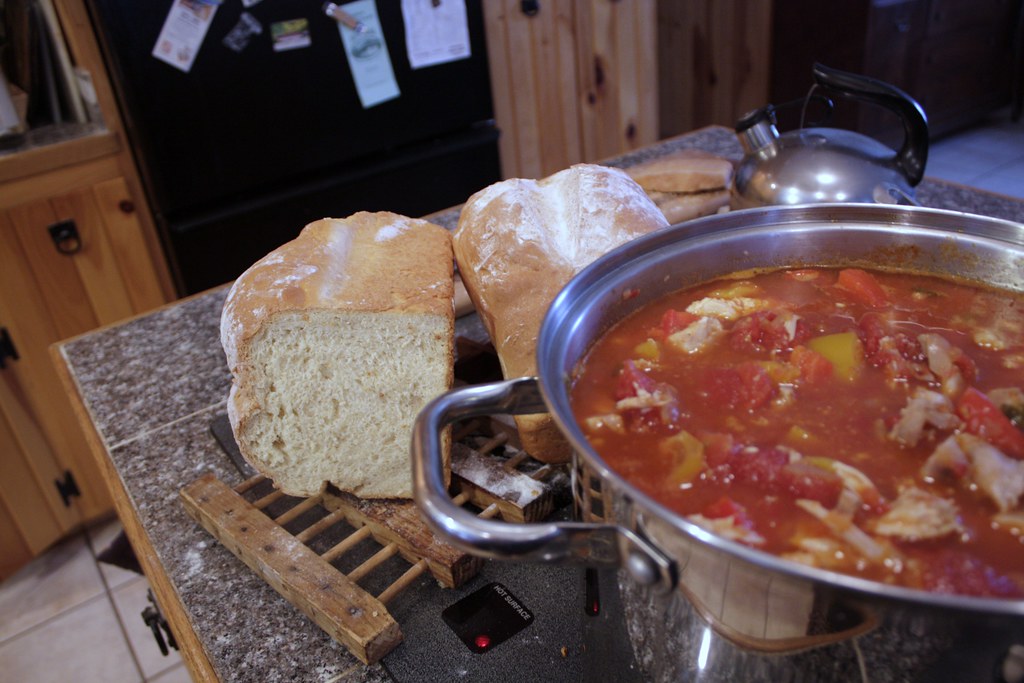 This bread is the best IF the dough isn't too dry! It should be a bit gooey. I nearly broke my standing mixer mixing a double batch of this! This photograph is of the loaves I made on the day I made chicken chili (the red stuff in the big pot). The dough rose faster than I expected on that day and so the bread is too high. This is now our white bread recipe of choice. Our favorite of all so far, though, is the cracked wheat recipe.
This bread is the best IF the dough isn't too dry! It should be a bit gooey. I nearly broke my standing mixer mixing a double batch of this! This photograph is of the loaves I made on the day I made chicken chili (the red stuff in the big pot). The dough rose faster than I expected on that day and so the bread is too high. This is now our white bread recipe of choice. Our favorite of all so far, though, is the cracked wheat recipe.Known around the company as Walter Sands' bread, this is the signature white sandwich loaf for many of us King Arthur Flour employee-owners, the "go-to" bread for breakfast toast, brown-bag PB & Js, or a grilled-cheese-and-soup supper. Just like King Arthur Flour itself, this bread is classic, reliable, and your best friend in the kitchen.
And who was Walter Sands? The Sands family became associated with King Arthur Flour in 1820, 30 years after the company's founding. Walter headed up the company from 1943 to 1968, when his son, Frank, took over as president. Frank led an effort that made King Arthur a national brand by the turn of the 21st century; several years ago he and his wife, Brinna, sold the company to us, the employee-owners.
Frank and Brinna are still the inspiration behind King Arthur's long-time quest: to serve our community, do the right thing, and provide Americans with the best flour in the world. We honor their legacy with this bread.
Follow our step-by-step photos for making this bread at our blog, Bakers' Banter.
* 1 cup + 2 tablespoons, to 1 1/4 cups lukewarm water*
* 1 heaping tablespoon honey
* 2 1/4 teaspoons instant yeast
* 1 3/4 teaspoons salt
* 2 tablespoons soft butter
* 4 cups King Arthur Unbleached All-Purpose Flour
* 1/3 cup Baker's Special Dry Milk or 1/2 cup nonfat dry milk granules
* *Use the lesser amount in summer or humid climates; the greater amount in winter or drier climates.
Directions
1) Mix all of the ingredients in the order listed, and mix and knead — by hand, or using a stand mixer — to make a smooth dough. It won't be particularly soft nor stiff; it should be smooth and feel bouncy and elastic under your hands.
2) Place the dough in a lightly greased bowl, or large (8-cup) measuring cup. Cover it, and let it rise for 60 to 90 minutes, till it's become quite puffy, though not necessarily doubled in size.
3) Gently deflate the dough, and shape it into a fat 9" log. Place it in a lightly greased 9" x 5" loaf pan.
4) Cover the pan, and let the dough rise for 60 to 90 minutes, till it's crowned 1" to 1 1/2" over the rim of the pan. Towards the end of the rising time, preheat the oven to 350°F.
5) Bake the bread for 20 minutes. Tent it lightly with aluminum foil, and bake for an additional 15 to 20 minutes, till it's golden brown. An instant-read thermometer inserted into the center will read 195°F to 200°F.
6) Remove the bread from the oven, and turn it out onto a rack to cool. When completely cool, wrap in plastic, and store at room temperature.
Yield: 1 large loaf, about 18 servings.

_/\_/\_
Comments
Post a Comment
I appreciate and welcome your comments. You can e-mail me directly at meeyauw at gmail dot com.